Analysis of Soil Moisture, Temperature, and Salinity in Cotton Field under Non-Mulched Drip Irrigation in South Xinjiang
Abstract
1. Introduction
2. Materials and Methods
2.1. Experimental Site
2.2. Experimental Design
2.3. Measurement of Factors and Methods
2.3.1. Soil Moisture Content and Temperature
2.3.2. Soil Salinity
2.3.3. Cotton Yield
2.3.4. Cotton Water Consumption
2.3.5. Water Use Efficiency
2.3.6. Data Processing
3. Results
3.1. Dynamic Changes in Soil Moisture with Different Drip Tape Layouts
3.2. Dynamic Changes in Soil Salinity in Different Drip Tape Layouts
3.3. Impacts of Different Drip Tape Layouts on Soil Temperature
3.4. Impacts of Drip Tape Layout on Water Consumption of Cotton
3.5. Impacts of Different Drip Tape Layouts on Cotton Yield and Irrigation Water Use Efficiency
4. Discussion
5. Conclusions
Author Contributions
Funding
Institutional Review Board Statement
Informed Consent Statement
Data Availability Statement
Acknowledgments
Conflicts of Interest
References
- Cao, H.; Wang, H.; Li, Y.; Hamani, A.K.M.; Zhang, N.; Wang, X.; Gao, Y. Evapotranspiration partition and dual crop coefficients in apple orchard with dwarf stocks and dense planting in arid region, Aksu oasis, southern Xinjiang. Agriculture 2021, 11, 1167. [Google Scholar] [CrossRef]
- Wang, X.; Wang, H.; Si, Z.; Gao, Y.; Duan, A. Modelling responses of cotton growth and yield to pre-planting soil moisture with the CROPGRO-Cotton model for a mulched drip irrigation system in the Tarim Basin. Agric. Water Manag. 2020, 241, 106378. [Google Scholar] [CrossRef]
- Yang, P.; Hu, H.; Tian, F.; Zhang, Z.; Dai, C. Crop coefficient for cotton under plastic mulch and drip irrigation based on eddy covariance observation in an arid area of northwestern China. Agric. Water Manag. 2016, 171, 21–30. [Google Scholar] [CrossRef]
- Wu, N.; Yang, C.; Luo, Y.; Sun, L. Estimating evapotranspiration and its components in cotton fields under deficit irrigation conditions. Pol. J. Environ. Stud. 2018, 28, 393–405. [Google Scholar] [CrossRef]
- Wang, D.; Wang, C.; Xu, L.; Bai, T.; Yang, G. Simulating growth and evaluating the regional adaptability of cotton fields with non-film mulching in Xinjiang. Agriculture 2022, 12, 895. [Google Scholar] [CrossRef]
- Dong, H.; Liu, T.; Li, Y.; Liu, H.; Wang, D. Effects of plastic film residue on cotton yield and soil physical and chemical properties in Xinjiang. Trans. CSAE 2013, 29, 91–99. [Google Scholar]
- Zhang, D.; Liu, H.; Hu, W.; Qin, X.; Ma, X.; Yan, C.; Wang, H. The status anddistribution characteristics of residual mulching film in Xinjiang, China. J. Integr. Agric. 2016, 15, 2639–2646. [Google Scholar] [CrossRef]
- Wang, L.; Lin, T.; Yan, C.; Wang, J.; Guo, R.; Yue, L.; Tang, Q. Effects of plastic film residue on evapotranspiration and soil evaporation in cotton field of Xinjiang. Trans. CSAE 2016, 32, 120–128. [Google Scholar]
- He, H.; Wang, Z.; Guo, L.; Zheng, X.; Zhang, J.; Li, W.; Fan, B. Distribution characteristics of residual film over a cotton field under long-term film mulching and drip irrigation in an oasis agroecosystem. Soil Till. Res. 2018, 180, 194–203. [Google Scholar] [CrossRef]
- Hu, C.; Wang, X.; Chen, X.; Tang, X.; Zhao, Y.; Yan, C. Current situation and control strategies of residual film pollution in Xinjiang. Trans. CSAE 2019, 35, 223–234. [Google Scholar]
- Jiang, X.; Liu, W.; Wang, E.; Zhou, T.; Xin, P. Residual plastic mulch fragments effects on soil physical properties and water flow behavior in the Minqin Oasis, northwestern China. Soil Till. Res. 2017, 166, 100–107. [Google Scholar] [CrossRef]
- Wang, Z.; Li, X.; Shi, H.; Xu, P.; Li, H. Water characteristic curve model for soil with residual plastic film. Trans. CSAE 2016, 32, 103–109. [Google Scholar]
- Yin, M.; Li, Y.; Fang, H.; Chen, P. Biodegradable mulching film with an optimum degradation rate improves soil environment and enhances maize growth. Agric. Water Manag. 2019, 216, 127–137. [Google Scholar] [CrossRef]
- Wang, H.; Cao, H.; Gao, Y.; Wang, X. The effects of drip-irrigation scheduling without mulching on soil moisture, yield and quality of cotton in southern Xinjiang. J. Irrig. Drain. 2020, 39, 26–34. [Google Scholar]
- Wang, X.; Zhou, Y.; Cao, S.; Liu, X.; Wang, M. Research on the present situation, harm and control countermeasures of mulch residue in cotton fields of Xinjiang corps. In Proceedings of the 2010 International Conference on Agricultural Engineering of Modern Agricultural Machineryapplication Seminar Subvenue, Shanghai, China, 18 September 2010; Chinese Society for Agricultural Machinery: Beijing, China, 2010; Volume 4. [Google Scholar]
- Jiang, Y.; Zheng, D.; Zhu, Z. Effects of remnant plastic film in soil on growth and yield of cotton. Agro-Environ. Prot. 2001, 20, 177–179. [Google Scholar]
- Liang, R.; Chen, X.; Zhang, B.; Meng, H.; Jiang, P.; Peng, X.; Kan, Z.; Li, W. Problems and countermeasures of recycling methods and resource reuse of residual film in cotton fields of Xinjiang. Trans. CSAE 2019, 35, 1–13. [Google Scholar]
- Liu, M.; Yang, J.; Li, X.; Yu, M.; Wang, J. Effects of irrigation water quality and drip tape arrangement on soil salinity, soil moisture distribution, and cotton yield (Gossypium hirsutum L.) Under Mulched Drip irrigation in Xinjiang, China. J. Inteng. Agric. 2012, 11, 502–511. [Google Scholar] [CrossRef]
- Liu, M.; Yang, J.; Li, X.; Yu, M.; Wang, J. Effects of drip irrigation strategy on cotton root distribution and water use efficiency. Trans. CSAE 2012, 28, 98–105. [Google Scholar]
- Wang, C.; Yang, P.; Yu, Y.; Di, F.; Huang, F. Effect of different pipe arrangements on soil water-salt transport and yield of cotton under mulched drip-irrigation. Agric. Res. Arid Areas 2016, 34, 38–45. [Google Scholar]
- Wang, Y.; Li, M.; Wei, C.; Zhang, J. Effect of drip-lines space on cotton root and plant growing under plastic mulched drip irrigation. J. Irrig. Drain. 2010, 29, 68–73. [Google Scholar]
- Liu, J.; Lv, X.; Wang, D.; Li, Z.; Xu, G. Influence of lateral layout of drip irrigation under plastic mulch on water transmission and effect of increase cotton production. Water Sav. Irrig. 2004, 6, 23–26. [Google Scholar]
- Grabow, G.L.; Huffman, R.L.; Evans, R.O.; Jordan, D.L.; Nuti, R.C. Water distribution from a subsurface drip irrigation system and dripline spacing effect on cotton yield and water use efficiency in a coastal plain soil. Trans. ASABE 2006, 49, 1823–1835. [Google Scholar] [CrossRef]
- Allen, R.G.; Periera, L.S.; Raes, D. Crop Evapotranspiration. Guidelines for Computing Crop Water Requirement; FAO Irrigation and Drainage Paper No. 56; FAO: Rome, Italy, 1998. [Google Scholar]
- Fontanet, M.; Scudiero, E.; Skaggs, T.H.; Fernà ndez-Garcia, D.; Ferrer, F.; Rodrigo, G.; Bellvert, J. Dynamic Management Zones for Irrigation Scheduling. Agric. Water Manag. 2020, 238, 106207. [Google Scholar] [CrossRef]
- Tan, S.; Wang, Q.; Zhang, J.; Chen, Y.; Shan, Y.; Xu, D. Performance of AquaCrop model for cotton growth simulation under film-mulched drip irrigation in southern Xinjiang, China. Agric. Water Manag. 2018, 196, 99–113. [Google Scholar] [CrossRef]
- Cheng, M.; Wang, H.; Fan, J.; Xiang, Y.; Liu, X.; Liao, Z.; Ahmed, E.A.; Zhang, F.; Li, Z. Evaluation of AquaCrop model for greenhouse cherry tomato with plastic film mulch under various water and nitrogen supplies. Agric. Water Manag. 2022, 274, 107949. [Google Scholar] [CrossRef]
- Fan, K.; Gao, Y.; Wang, X.; Wang, H.; Duan, A. Study on cotton drip irrigation under film mulching in southern Xinjiang based on meteorological information. Agric. Res. Arid Areas 2019, 37, 83–90. [Google Scholar]
- Che, Z.; Wang, J.; Li, J. Effects of water quality, irrigation amount and nitrogen applied on soil salinity and cotton production under mulched drip irrigation in arid Northwest China. Agric. Water Manag. 2021, 247, 106738. [Google Scholar] [CrossRef]
- Cai, H.; Shao, G.; Zhang, Z. Water demand and irrigation scheduling of drip irrigation for cotton under plastic mulch. J. Hydraul. E 2002, 11, 119–123. [Google Scholar]
- Wang, X.; Jiang, F.; Wang, H. Irrigation Scheduling Optimization of Drip-irrigated without Plastic Film Cotton in South Xinjiang Based on Aqua Crop Model. Trans. CSAM 2021, 52, 293–301, 335. [Google Scholar]
- Tian, Z.; Ren, T.; Horton, R.; Heitman, J.L. Estimating soil bulk density with combined commercial soil water content and thermal property sensors. Soil Till. Res. 2020, 196, 104445. [Google Scholar] [CrossRef]
- Lo, T.H.; Rudnick, D.R.; Singh, J.; Nakabuye, H.N.; Katimbo, A.; Heeren, D.M.; Ge, Y. Field assessment of interreplicate variability from eight electromagnetic soil moisture sensors. Agric. Water Manag. 2020, 231, 105984. [Google Scholar] [CrossRef]
- Cui, Y.; Wang, F.; Sun, J.; Han, Q.; Wang, J.; Li, N. Effects of irrigation regimes on the variation of soil water and salt and yield of mechanically harvested cotton in Southern Xinjiang, China. Chin. J. Appl. Ecol. 2018, 29, 3634–3642. [Google Scholar]
- Wang, F.; Sun, J.; Liu, Z.; Ning, H.; Qiang, X.; Shen, X. Effect of different irrigation scheduling on salt distribution and leaching in cotton field. Trans. CSAM 2013, 44, 120–127. [Google Scholar]
- Sandhu, R.; Irmak, S. Assessment of AquaCrop model in simulating maize canopy cover, soil-water, evapotranspiration, yield, and water productivity for different planting dates and densities under irrigated and rainfed conditions. Agric. Water Manag. 2019, 224, 105753. [Google Scholar] [CrossRef]
- Wang, M.; Lv, T.; He, X.; Cao, Y.; Wang, D. Effects of drip-irrigated planting modes on soil water, temperature, salt and cotton growth. Agric. Res. Arid Areas 2018, 36, 176–186. [Google Scholar]
- Li, J.; Wang, J.; Li, N.; Hao, X.; Shi, X.; Tian, Y.; Shi, F.; Luo, H.; Yang, G. Yield of non-film cotton and the response of temperature, humidity and salt in the root zone to irrigation. Trans. CSAE 2021, 37, 134–143. [Google Scholar]
- Gu, Z.; Qi, Z.; Ma, L.; Gui, D.; Xu, J.; Fang, Q.; Yuan, S.; Feng, G. Development of an irrigation scheduling software based on model predicted crop water stress. Comput. Electron. Agric. 2017, 143, 208–221. [Google Scholar] [CrossRef]
- Savva, A.P.; Frenken, K. Crop Water Requirements and Irrigation Scheduling; FAO Sub-Regional Office for East and Southern Africa: Harare, Zimbabwe, 2002. [Google Scholar]
- Vellidis, G.; Liakos, V.; Andreis, J.H.; Perry, C.D.; Porter, W.M.; Barnes, E.M.; Morgan, K.T.; Fraisse, C.; Migliaccio, K.W. Development and assessment of a smartphone application for irrigation scheduling in cotton. Comput. Electron. Agric. 2016, 127, 249–259. [Google Scholar] [CrossRef]
- Gu, Z.; Yuan, S.; Qi, Z.; Wang, X.; Cai, B.; Zheng, Z. Real-time precise irrigation scheduling and control system in solar greenhouse based on ET and water balance. Trans. CSAE 2018, 23, 101–108. [Google Scholar]
- Sánchez-Molina, J.A.; Rodríguez, F.; Guzmán, J.L.; Ramírez-Arias, J.A. Water content virtual sensor for tomatoes in coconut coir substrate for irrigation control design. Agric. Water Manag. 2015, 151, 114–125. [Google Scholar] [CrossRef]
- Feng, S.; Jiang, J.; Huo, Z.; Zhang, C. Optimization of irrigation scheduling under deficit irrigation with saline water for spring wheat based on SWAP model. Trans. CSAE 2014, 30, 66–75. [Google Scholar]
- Lu, X.; Zhang, L.; Liu, H.; Zhi, C.; Li, J. Design of the networked precision irrigation system for paddy field crops in intelligent agriculture. Trans. CSAE 2021, 17, 71–81. [Google Scholar]
- Liu, M.; Yang, J.; Li, X.; Yu, M.; Wang, J. Effects of irrigation amount and frequency on soil water distribution and water use efficiency in a cotton field under mulched drip irrigation. Chin. J. Appl. Ecol. 2011, 22, 3203–3210. [Google Scholar]
- Wang, X. Effects of Winter-Spring Irrigation on Soil Water-Salt Dynamics and Cotton Growth. Ph.D. Dissertation, Chinese Academy of Agricultural Sciences Dissertation, Beijing, China, 2018. [Google Scholar]
- Wu, C.; Hu, S.; Zhao, C. Dynamic change of soil moisture and water consumption of cotton under drip irrigation patterns in Tarim irrigation area. Water Sav. Irrig. 2016, 2, 14–17. [Google Scholar]
- Wang, Y.; Li, M.; Lan, M. Effect of soil wetting pattern on cotton-root distribution and plant growth under plastic mulched drip irrigation in field. Trans. CSAE 2011, 27, 31–38. [Google Scholar]
- Li, D.; Li, M.; Liu, D.; Lv, M.; Jia, Y. Effects of soil wetting pattern on the soil waterthermal environment and cotton root water consumption under mulched drip irrigation. Chin. J. Appl. Ecol. 2015, 26, 2437–2444. [Google Scholar]
- Yang, X.; Dong, X.; Liu, L. Study on transportation of water and salt in soil under two tapes positioning style for drip irrigation under film of Cotton. Water Sav. Irrig. 2011, 2, 40–42, 45. [Google Scholar]
- Li, H.; Xia, Z.; Ma, G. Effects of water content variation on soil temperature process and water exchange. J. Hohai Univ. 2007, 35, 172–175. [Google Scholar]
- Feng, B.; Zhang, Z.; Zhang, J.; Wang, Z. Review of effect of temperature on soil water movement. Adv. Water. Sci. 2002, 13, 643–648. [Google Scholar]
- Wang, H.; Zhao, L.; Gao, Y.; Wang, X.; Cao, H. Study on Irrigation Mode and Water Consumption of Cotton Drip Irrigation Without Film in South Xinjiang. J. Agric. Sci. Technol. 2021, 23, 153–160. [Google Scholar]
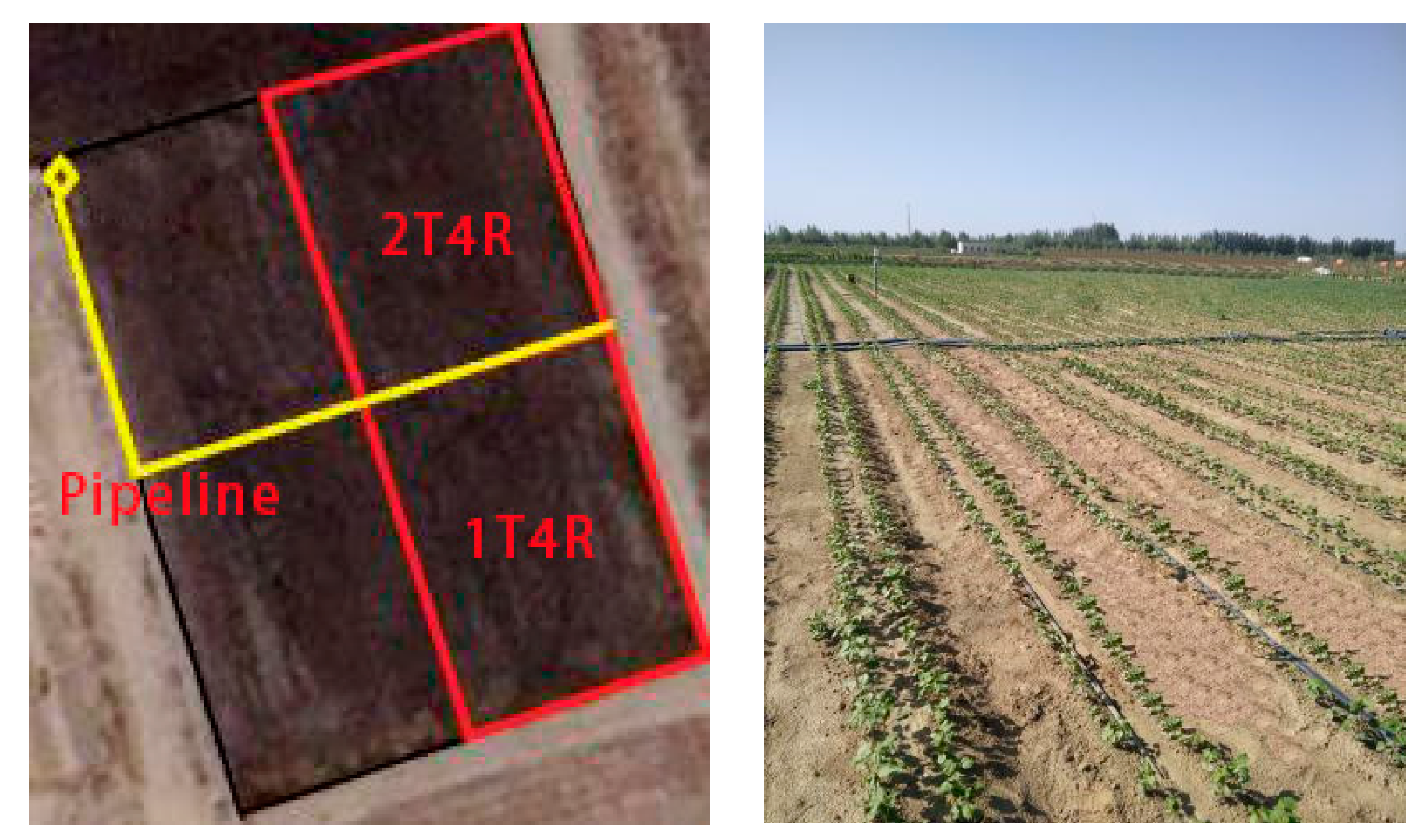
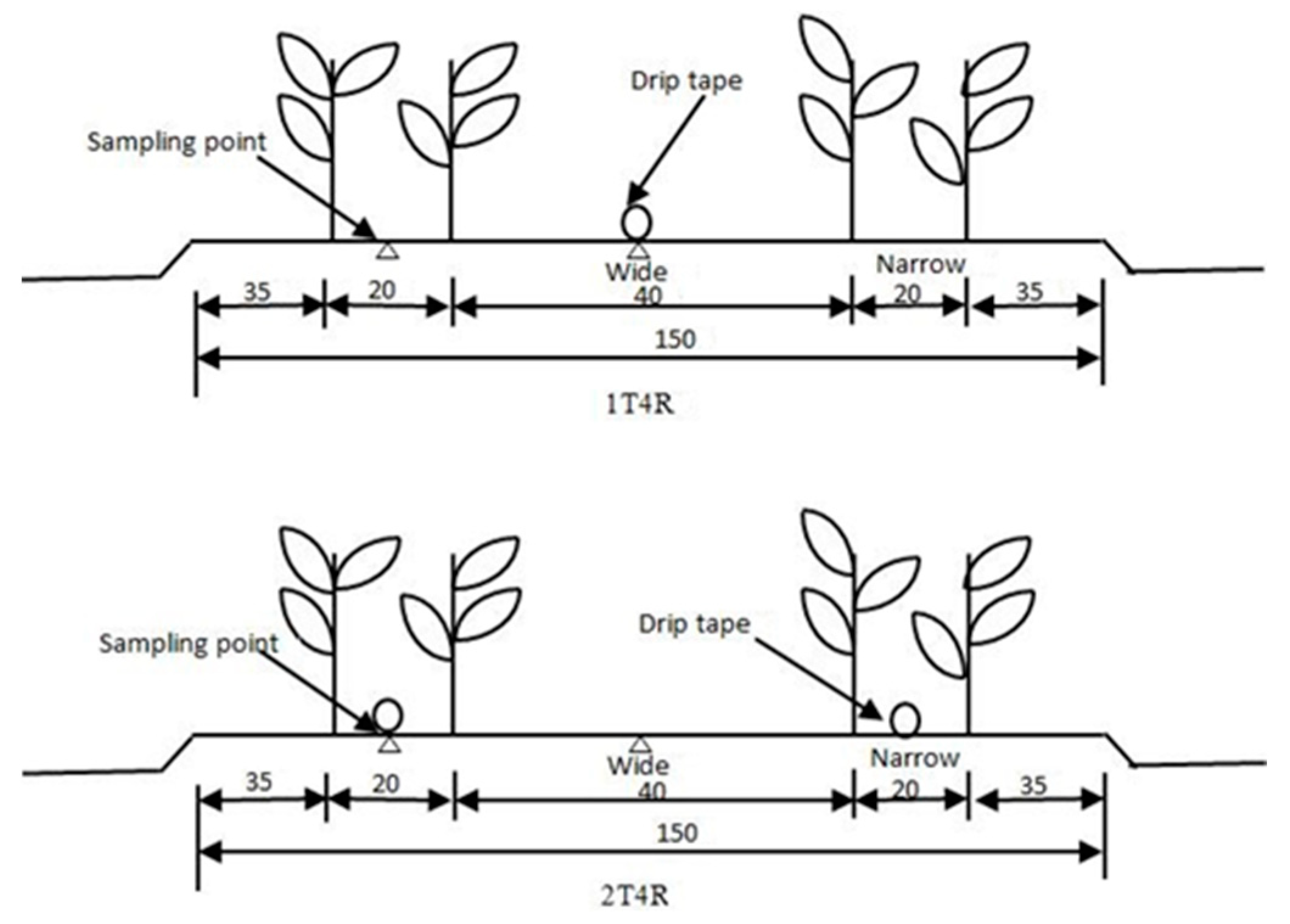
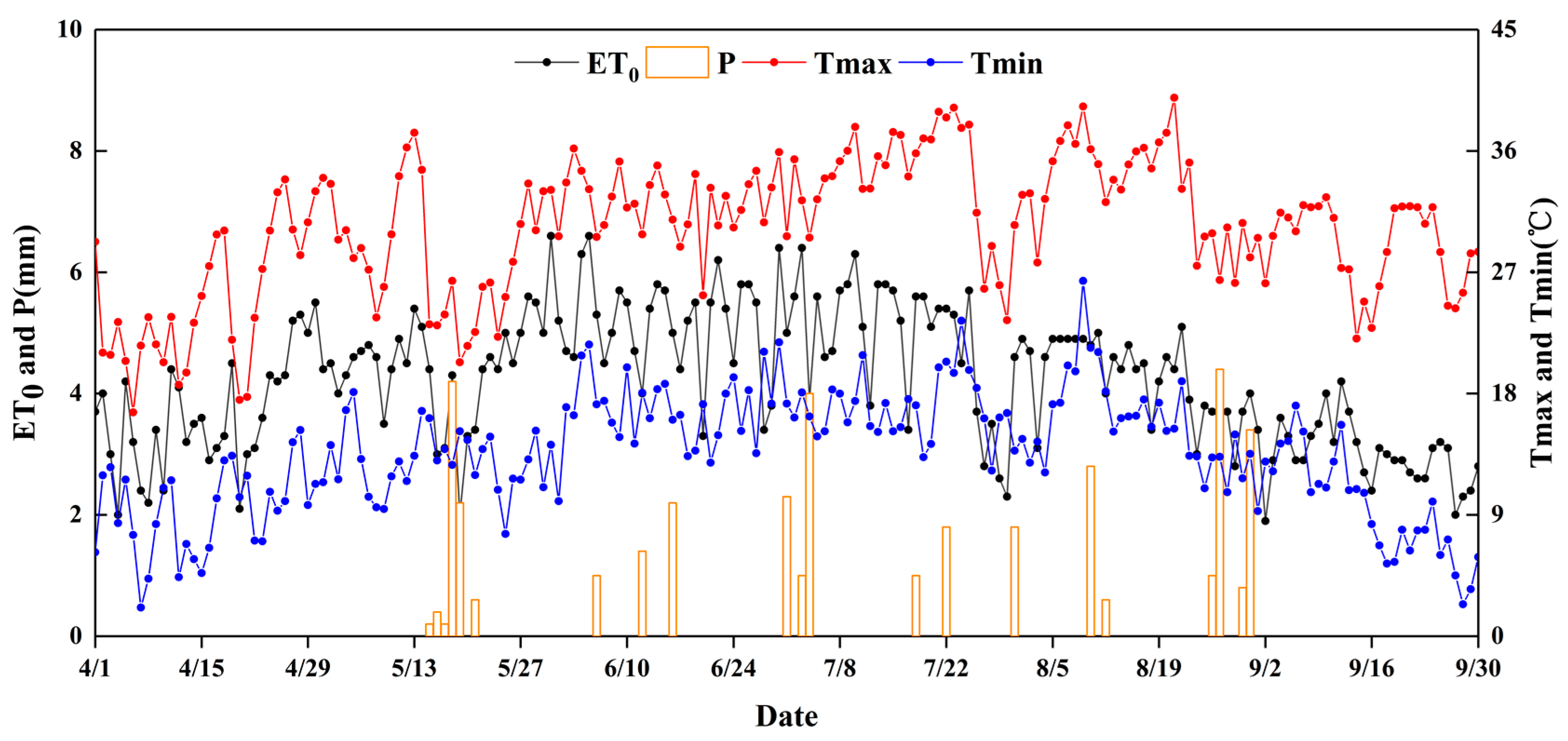
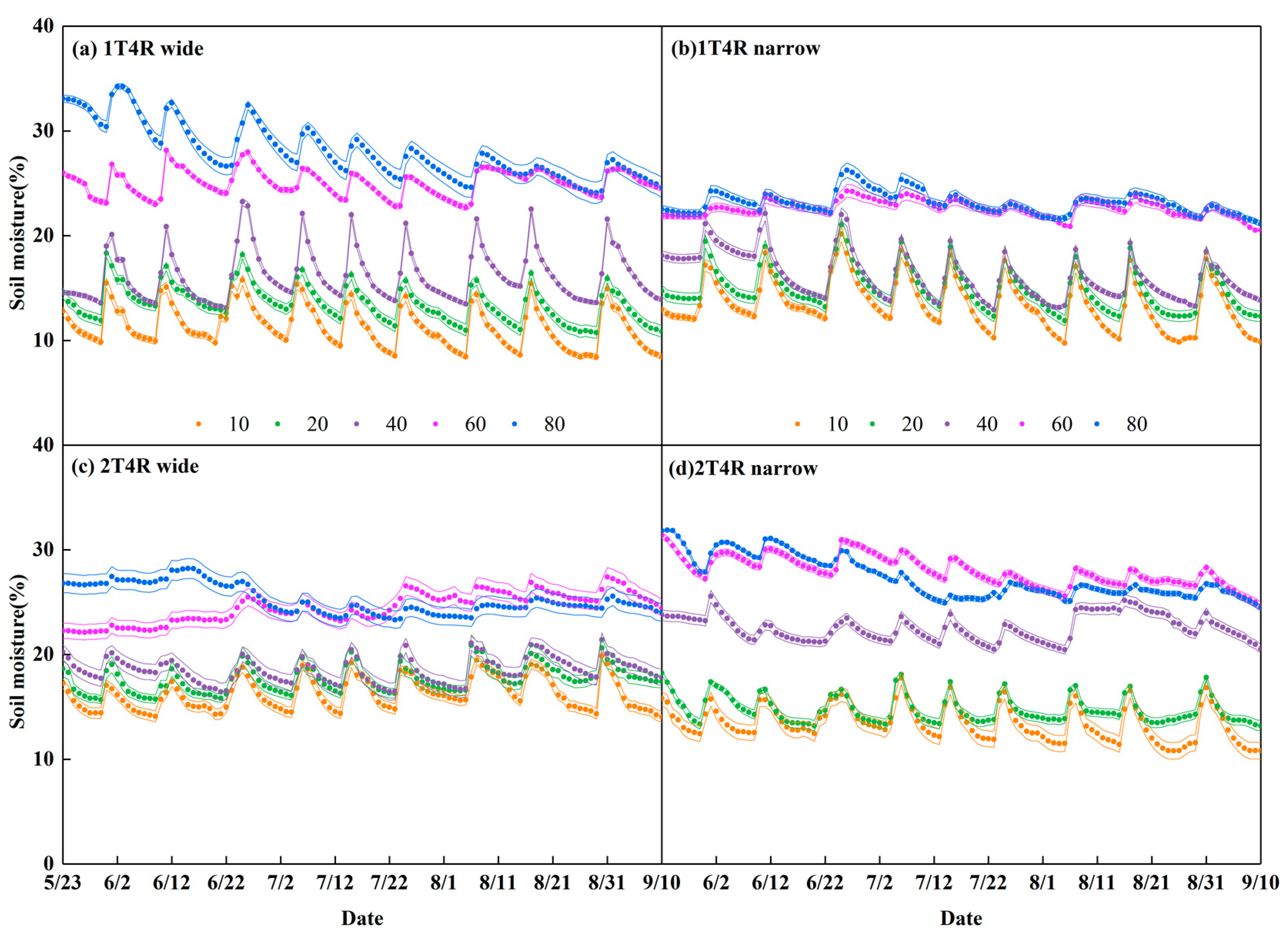
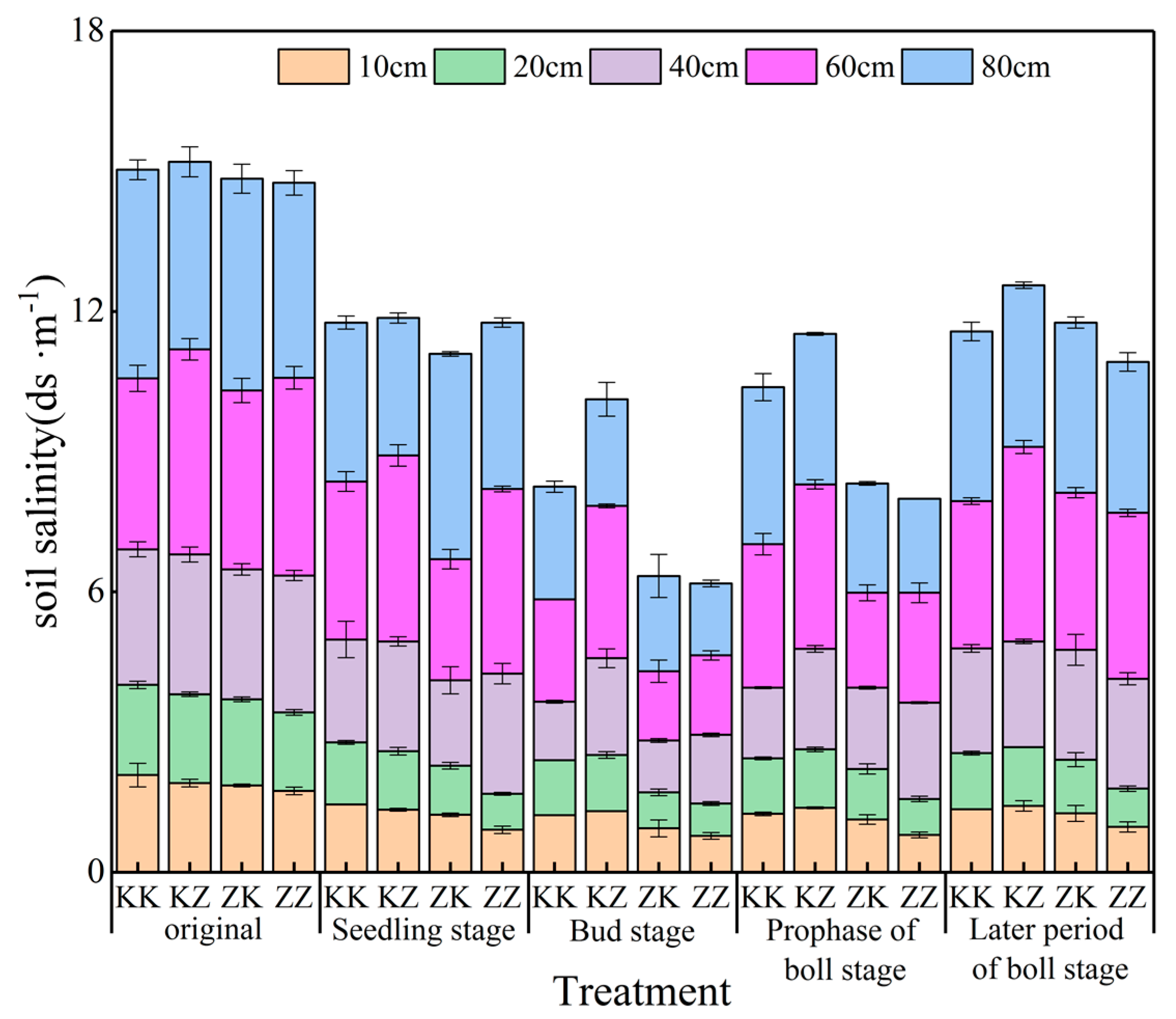
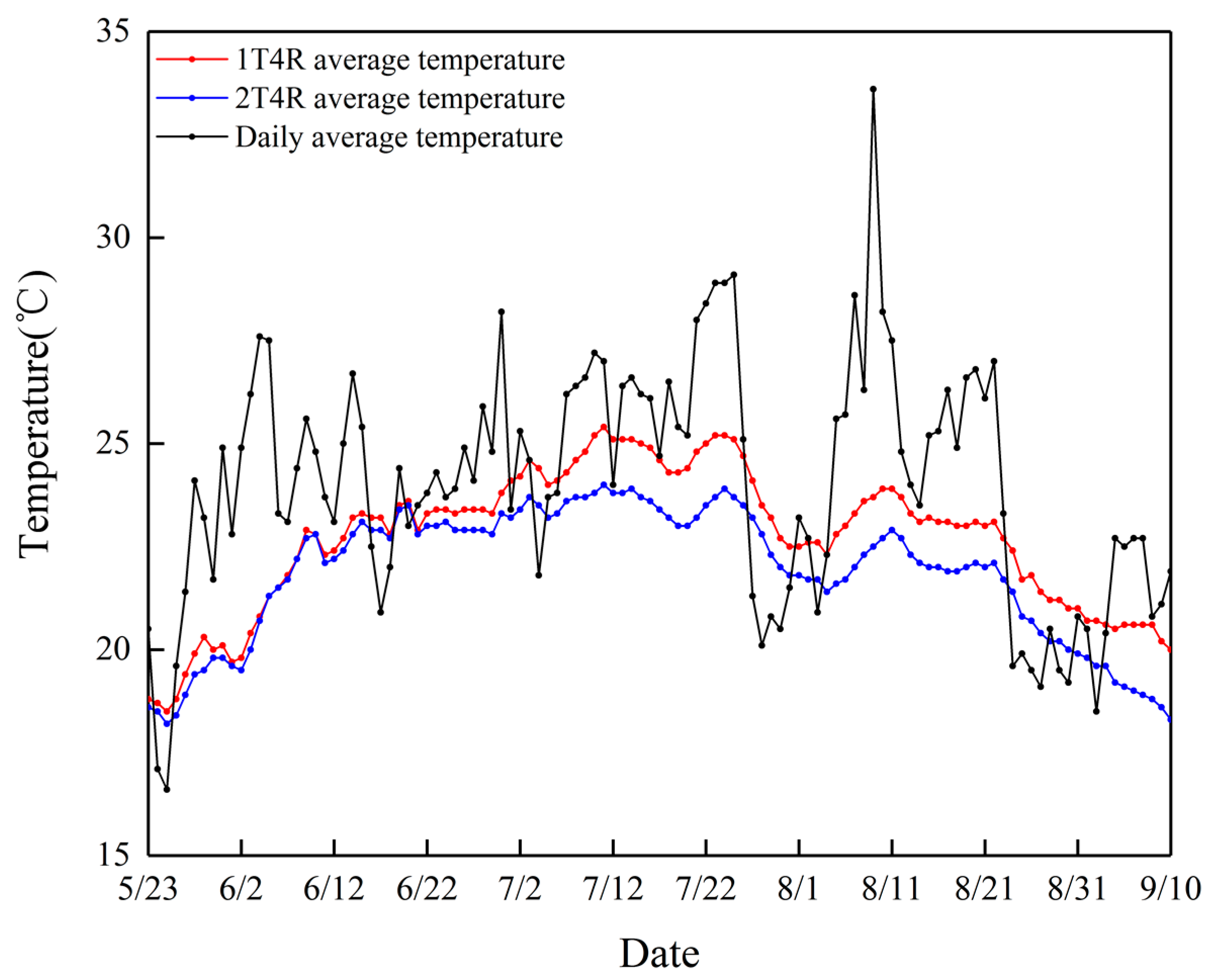
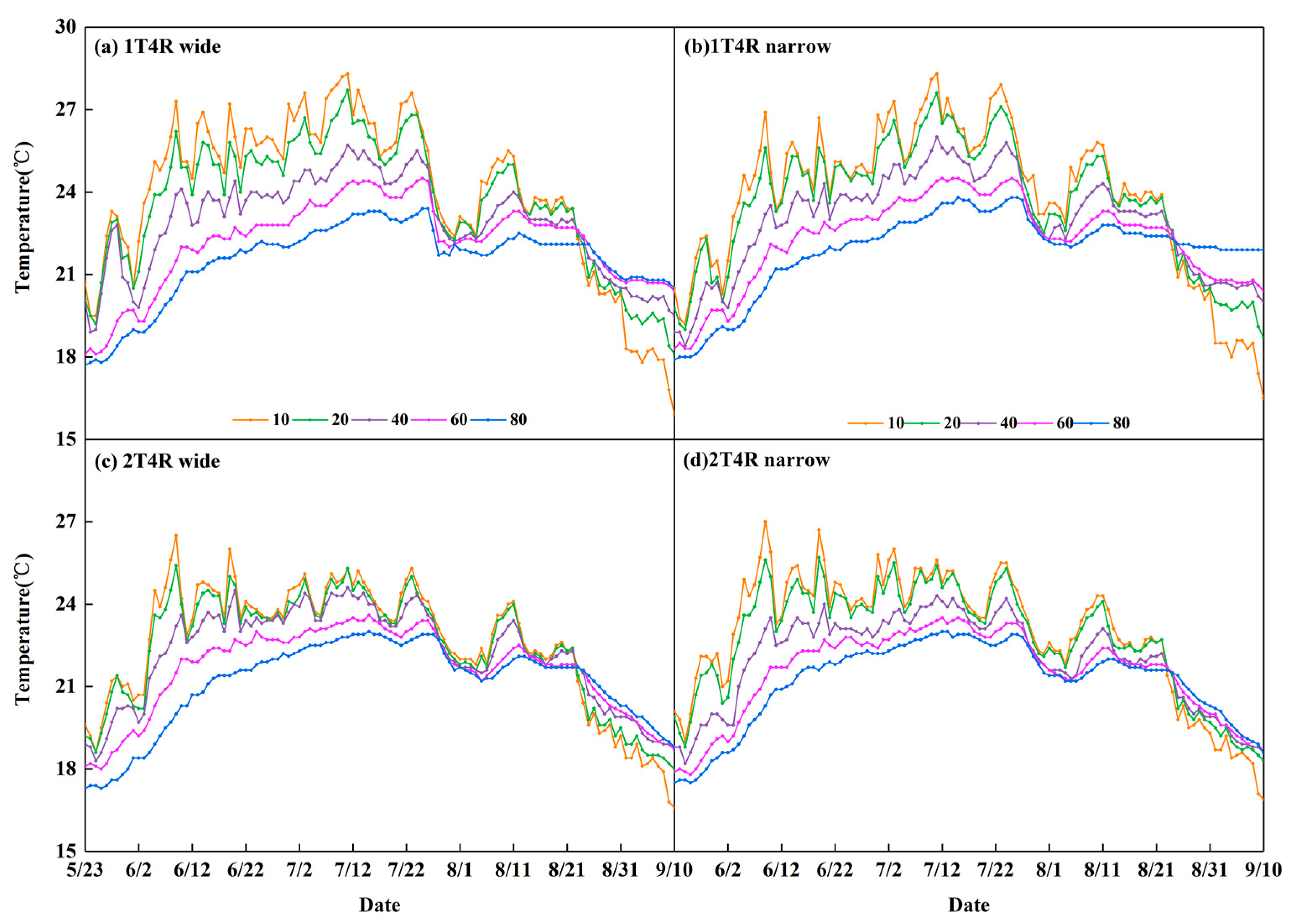
| Irrigation Quota | Irrigation Date |
|---|---|
| 45 | 22 May 2018 |
| 45 | 31 May 2018 |
| 45 | 10 June 2018 |
| 45 | 23 June 2018 |
| 45 | 5 July 2018 |
| 45 | 14 July 2018 |
| 45 | 24 July 2018 |
| 45 | 6 August 2018 |
| 45 | 16 August 2018 |
| 45 | 31 August 2018 |
| Growth Stage | Date | Growing Days (d) |
|---|---|---|
| Sowing–emergence | 22 to 30 April 2018 | 8 |
| Emergence stage–seedling stage | 1 May 2018 to 29 June 2018 | 60 |
| Seedling stage–bud stage | 30 June to 2 August 2018 | 33 |
| Bud stage–prophase of boll stage | 3 August to 21 August 2018 | 18 |
| Prophase –later period of boll stage | 22 August to 10 September 2018 | 19 |
| Later period of boll stage–floating period | 11 September to 27 October 2018 | 46 |
| Treatment | Seedling Stage | Bud Stage | Flower Bell Period | ||||||
|---|---|---|---|---|---|---|---|---|---|
| IA | WC | ADWC | IA | WC | ADWC | IA | WC | ADWC | |
| (mm) | (mm) | (mm d−1) | (mm) | (mm) | (mm d−1) | (mm) | (mm) | (mm d−1) | |
| 1T4R | 180 | 194.58a | 3.24a | 135 | 151.82a | 4.60a | 135 | 142.48a | 3.85a |
| 2T4R | 180 | 208.72a | 3.48a | 135 | 159.42a | 4.83a | 135 | 145.90a | 3.94a |
| Treatment | BN | BM (g) | Yield (kg hm−2) | TIA (mm) | TWC (mm) | WUEET (kg m−3) | WUEI (kg m−3) |
|---|---|---|---|---|---|---|---|
| 1T4R | 4.40a | 4.58a | 4947.96a | 450 | 488.87a | 1.01a | 1.10a |
| 2T4R | 4.52a | 4.62a | 5122.91a | 450 | 514.04a | 1.00a | 1.14a |
Publisher’s Note: MDPI stays neutral with regard to jurisdictional claims in published maps and institutional affiliations. |
© 2022 by the authors. Licensee MDPI, Basel, Switzerland. This article is an open access article distributed under the terms and conditions of the Creative Commons Attribution (CC BY) license (https://creativecommons.org/licenses/by/4.0/).
Share and Cite
Wang, H.; Cao, H.; Jiang, F.; Wang, X.; Gao, Y. Analysis of Soil Moisture, Temperature, and Salinity in Cotton Field under Non-Mulched Drip Irrigation in South Xinjiang. Agriculture 2022, 12, 1589. https://doi.org/10.3390/agriculture12101589
Wang H, Cao H, Jiang F, Wang X, Gao Y. Analysis of Soil Moisture, Temperature, and Salinity in Cotton Field under Non-Mulched Drip Irrigation in South Xinjiang. Agriculture. 2022; 12(10):1589. https://doi.org/10.3390/agriculture12101589
Chicago/Turabian StyleWang, Hongbo, Hui Cao, Fuchang Jiang, Xingpeng Wang, and Yang Gao. 2022. "Analysis of Soil Moisture, Temperature, and Salinity in Cotton Field under Non-Mulched Drip Irrigation in South Xinjiang" Agriculture 12, no. 10: 1589. https://doi.org/10.3390/agriculture12101589
APA StyleWang, H., Cao, H., Jiang, F., Wang, X., & Gao, Y. (2022). Analysis of Soil Moisture, Temperature, and Salinity in Cotton Field under Non-Mulched Drip Irrigation in South Xinjiang. Agriculture, 12(10), 1589. https://doi.org/10.3390/agriculture12101589







